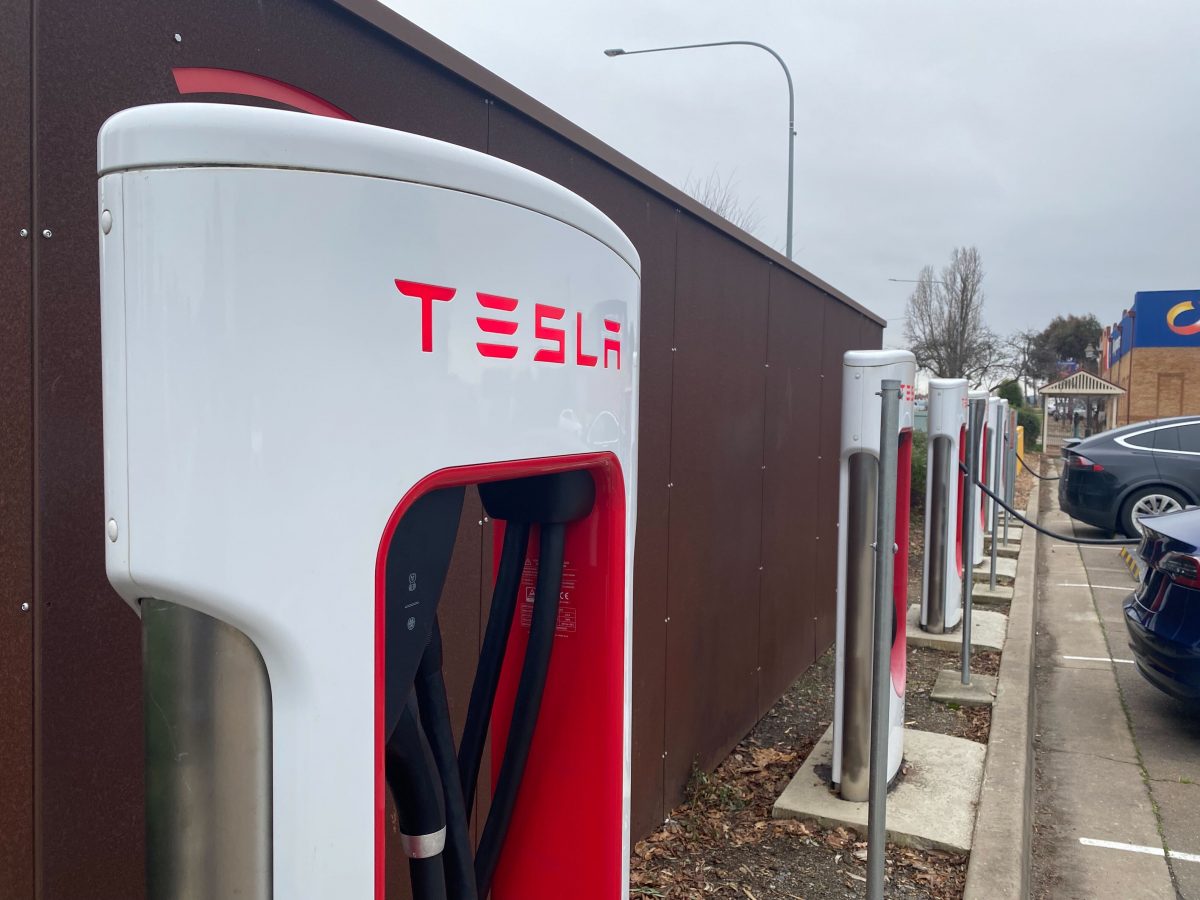
They’re limited to Teslas, for now. Photo: Stephen Ning.
The headline news for the iPhone 15, revealed last week, is that Apple has swapped out its ‘Lighting’ charging port for the same type used by Android for years – the USB-Type C.
But our own version of this is unfolding in the ACT where there are calls for the local government to encourage the Apple of the car world – Tesla – to make a similar change.
At the moment, if an electric vehicle (EV) charger says ‘Tesla’ on it – complete with the characteristic red and white colour combination – it can only charge a Tesla. These include the ‘Destination’ chargers at places like the Canberra Centre and the ‘Supercharger’ at Majura Park.
But a recent committee inquiry into EV adoption in the ACT recommends the best-selling US brand open up their charger network to all EV owners as part of a ‘non-Tesla Supercharger pilot’.
Tesla launched the pilot in November 2021 across a select number of countries, including Australia, to make “some” stations accessible to non-Tesla EV drivers, provided they have the Tesla app.
“It’s always been our ambition to open the Supercharger network to non-Tesla EVs, and by doing so, encourage more drivers to go electric,” Tesla says.
Chaired by Jo Clay from the ACT Greens, Labor’s Suzanne Orr and Mark Parton from the Canberra Liberals, the committee inquiry has spent the past 15 months gleaning comments from Canberrans on how to improve EV uptake in the Territory.
They handed down a list of 30 recommendations to the ACT Government on 15 September 2023, including one about “encouraging Tesla to include a charging location within the ACT in its pilot program extending the ‘supercharger’ network to non-Tesla vehicles”.
“The Tesla supercharger pilot program would provide a good opportunity to expand the ACT’s network of fast chargers,” the report read.

Kingston resident Stephen Ning and his 2021 Tesla Model 3. Photo: Michelle Kroll.
It’s part of an attempt to address the main concern among today’s EV buyers – charging anxiety.
“A common media comment is that ‘charging anxiety’ (finding a queue or an out-of-order charger) is replacing ‘range anxiety’,” a submission by the ACT branch of the Australian Electric Vehicle Association (AEVA ACT) read.
AEVA ACT noted that out-of-service chargers are “a cause of considerable frustration among EV drivers and could erode public confidence in EVs”.
The local government maintains there are chargers at “appropriate intervals on major routes connecting the ACT with NSW”, but the numbers of chargers at each location are often “low”.
The committee recommended the government work with other jurisdictions to install more chargers along major routes to and from Canberra and singled out the “popular route” to the South Coast. Braidwood and Nelligen, on either side of the Clyde, as possibilities.
Closer to home, the committee said it’s important there is a “more equitable geographic spread of chargers” at shopping centres, tourism locations and sporting facilities in the government’s plans to install 180 public chargers across Canberra by 2025.
They also said all residents – “regardless of what type of housing they are in” – should have access to an EV charger at their residence.
Inspired by schemes around the world, AEVA ACT suggested this take the form of retrofitting lamp posts in new suburbs like Wright, Coombs, and Denman Prospect with power sockets so those who park on the street can still charge up their EVs.
“Similarly, lamp posts around shopping, cafes and other commercial precincts that depend on-street parking could be retrofitted,” the submission read.

Councils and charge point operators in NSW can apply for a slice of $3 million to install a kerbside EV charger until 17 November. Photo: NSW Government.
For those in apartment complexes, the committee acknowledged the sheer cost of adding EV charging capability, from running cables to upgrading the building’s – and sometimes the whole street’s – electrical substation.
They recommended the ACT Government provide “one-off grants” to body corporates so they can assess whether their building can be retrofitted to accommodate charging infrastructure and how much it would cost.
The committee even had a recommendation for those who don’t own their own home.
“The committee is of the view that renters who own EVs should not be restricted in their ability to access appropriate charging infrastructure and that landlords should be incentivised to install charging infrastructure for their tenants.”
Then there’s the question of where all this power is coming from, especially as the ACT Government prepares to phase out gas connections and wood burners by 2045 and place even greater demand on the electrical grid.
In its submission, Evoenergy described EV charging as “quite a substantial load, relative to a dishwasher, a refrigerator or any of those sorts of items” and that it would have “a material impact on the ACT electricity network in the upcoming years”.
Its long-term modelling indicates the ACT’s electricity demand by the winter of 2045 will reach almost 1000 megawatts, or more than 100 per cent more than the current winter peak.
The ACT Government maintains EV charging has had a smaller impact on the grid than expected but admits it needs to undertake a new study “due to EV uptake being higher than expected”.
The committee asked the government to reveal this modelling by the last sitting week of 2023 (28 to 30 November).
The ACT Government will consider the inquiry’s findings over the coming months.




















